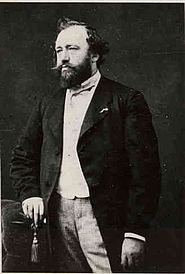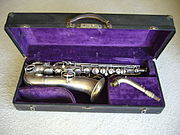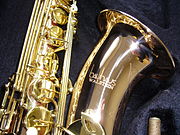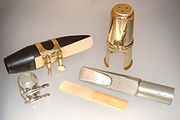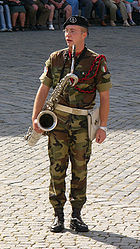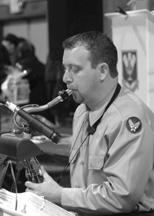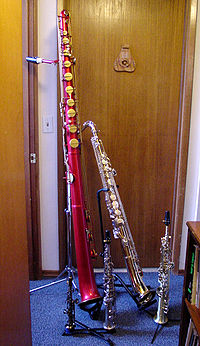
Saxophone
Background Information
SOS Children, which runs nearly 200 sos schools in the developing world, organised this selection. All children available for child sponsorship from SOS Children are looked after in a family home by the charity. Read more...
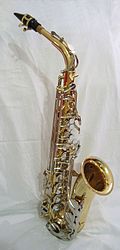 An alto saxophone in E♭ |
|
| Woodwind | |
|---|---|
| Classification | Woodwind |
| Hornbostel–Sachs classification | 422.212-71 ( Single-reeded aerophone with keys) |
| Inventor(s) | Adolphe Sax |
| Developed | 28th June 1841 |
| Playing range | |
|
Written Range: |
|
| Related instruments | |
|
Military band family:
Orchestral family:
|
|
| Musicians | |
| List of saxophonists | |
The saxophone (also referred to as the sax) is a conical- bored transposing musical instrument that is a member of the woodwind family. Saxophones are usually made of brass and played with a single-reed mouthpiece similar to that of the clarinet. The saxophone was invented by the Belgian Adolphe Sax in 1841. He wanted to create an instrument that would both be the most powerful and vocal of the woodwinds and the most adaptive of the brass, which would fill the then vacant middle ground between the two sections. He patented the sax in 1846 in two groups of seven instruments each. Each series consisted of instruments of various sizes in alternating transposition. The series pitched in B♭ and E♭, designed for military bands, has proved extremely popular and most saxophones encountered today are from this series. A few saxophones remain from the less popular orchestral series pitched in C and F.
While proving very popular in its intended niche of military band music, the saxophone is most commonly associated with popular music, big band music, blues, early rock and roll, ska and particularly jazz. There is also a substantial repertoire of concert music in the classical idiom for the members of the saxophone family. Saxophone players are called saxophonists.
History
The saxophone was developed in the 1840s by Adolphe Sax, a Belgian-born instrument-maker, flautist, and clarinetist working in Paris. While still working at his father's instrument shop in Brussels, Sax began developing an instrument which had the projection of a brass instrument with the agility of a woodwind. Another priority was to invent an instrument which would overblow at the octave, unlike the clarinet, which rises in pitch by a twelfth when overblown; an instrument which overblew at the octave would have identical fingering for both registers.
Prior to his work on the saxophone, Sax made several improvements to the bass clarinet by improving its keywork and acoustics and extending its lower range. Sax was also a maker of the then-popular ophicleide, a large conical brass instrument in the bass register with keys similar to a woodwind instrument. His experience with these two instruments allowed him to develop the skills and technologies needed to make the first saxophones. Adolphe Sax created an instrument with a single reed mouthpiece like a clarinet, conical brass body like an ophicleide, and the acoustic properties of both the french horn and the clarinet.
Having constructed saxophones in several sizes in the early 1840s, Sax applied for, and received, a 15-year patent for the instrument on June 28, 1846. The patent encompassed 14 versions of the fundamental design, split into two categories of seven instruments each and ranging from sopranino to contrabass. Although the instruments transposed at either F or C have been considered "orchestral", there is no evidence that Sax intended this. As only 3% of Sax's surviving production were pitched in F and C, and as contemporary composers used the Eb alto and Bb bass saxophone freely in orchestral music, it is almost certain that Sax experimented to find the most suitable keys for these instruments, settling upon instruments alternating between E♭ and B♭ rather than those pitched in F and C, for reasons of tone and economy (the saxophones were the most expensive wind musical instruments of their day). The C soprano saxophone was the only instrument to sound at concert pitch. All the instruments were given an initial written range from the B below the treble staff to the F three ledger lines above it, giving each saxophone a range of two and a half octaves.
Sax's patent expired in 1866; thereafter numerous saxophonists and instrument manufacturers implemented their own improvements to the design and keywork. The first substantial modification was by a French manufacturer who extended the bell slightly and added an extra key to extend the range downwards by one semitone to B♭. It is suspected that Sax himself may have attempted this modification. This extension was adopted into almost all modern designs.
Sax's original keywork, which was based on the Triebert system 3 oboe for the left hand and the Boehm clarinet for the right, was very simplistic and made playing some legato passages and wide intervals extremely difficult to finger, so numerous developers added extra keys and alternate fingerings to make chromatic playing less difficult. While the early saxophone had two separate octave vents to assist in the playing of the upper registers just as modern instruments do, players of Sax's original design had to operate these via two separate octave keys operated by the left thumb. A substantial advancement in saxophone keywork was the development of a method by which both tone holes are operated by a single octave key by the left thumb which is now universal on all modern saxophones. One of the most radical, however temporary, revisions of saxophone keywork was made in the 1950s by M. Houvenaghel of Paris, who completely redeveloped the mechanics of the system to allow a number of notes (C♯, B, A, G, F and E♭) to be flattened by a semitone simply by lowering the right middle finger. This enables a chromatic scale to be played over two octaves simply by playing the diatonic scale combined with alternately raising and lowering this one digit. However, this keywork never gained much popularity, and is no longer in use.
Description
The saxophone consists of an approximately conical tube of thin metal, most commonly brass and sometimes plated with silver, gold, and nickel, flared at the tip to form a bell. At intervals along the tube are between 20 and 23 tone holes of varying size, including two very small 'speaker' holes to assist the playing of the upper register. These holes are covered by keys (also known as pad cups), containing soft leather pads, which are closed to produce an airtight seal; at rest some of the holes stand open and others are closed. The keys are controlled by buttons pressed by the fingers, while the right thumb sits under a thumb rest to help keep the saxophone balanced. The fingering for the saxophone is a combination of that of the oboe with the Boehm system, and is very similar to the flute or the upper register of the clarinet. Instruments that play to low A have a left thumb key for that note.
The simplest design of saxophone is a straight conical tube, and the sopranino and soprano saxophones are usually of this straight design. However, as the lower-pitched instruments would be unacceptably long if straight, for ergonomic reasons the larger instruments usually incorporate a U-bend at or slightly above the third-lowest tone hole. As this would cause the bell of the instrument to point almost directly upwards, the end of the instrument is either bevelled or tilted slightly forwards. This U-shape has become an iconic feature of the saxophone family, to the extent that soprano and even sopranino saxes are sometimes made in the curved style even though this is not strictly necessary. By contrast, tenors and even baritones have occasionally been made in the straight style. Most commonly, however, the alto and tenor saxophones incorporate a curved 'crook' above the highest tone hole but below the top speaker hole, tilting the mouthpiece through 90 degrees; the baritone, bass and contrabass extend the length of the bore mainly by double-folding this section.
Materials
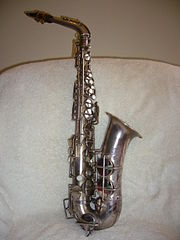

Most saxophones, both past and present, are made from brass. Despite this, they are categorized as woodwind instruments rather than brass, as the sound waves are produced by an oscillating reed, not the player's lips against a mouthpiece as in a brass instrument, and because different pitches are produced by opening and closing keys. Brass is used to make the body of the instrument; the pad cups; the rods that connect the pads to the keys; the keys themselves and the posts that hold the rods and keys in place. The screw pins that connect the rods to the posts, and the needle springs and leaf springs that cause the keys to return to their rest position after being released, are generally made of blued or stainless steel. Since 1920, most saxophones have 'key touches' (smooth decorative pieces placed where the fingers touch the instrument) made from either plastic or mother of pearl.
Other materials have been tried with varying degrees of success, such as the 1950s Grafton plastic alto saxophone. A few companies, such as Yanagisawa and Bauhaus Walstein, have made some saxophone models from phosphor bronze because of its slightly different tonal qualities. For example, although their designs are identical apart from the metal used, the bronze Yanagisawa A992 saxophones are said to sound "darker" than the brass versions. Yanagisawa and other manufacturers, starting with the King Super 20 around 1950, have made saxophone necks, bells, or entire instruments from sterling silver. Keilwerth and P. Mauriat have made saxes with a nickel silver body like that of a flute. The effect of material on sound is controversial among sax players, and little solid research has been published.
After completing the instrument, manufacturers usually apply a thin coating of clear or colored acrylic lacquer, or silver plate, over the bare brass. The lacquer or plating serves to protect the brass from oxidation, and maintains its shiny appearance. Several different types and colors of surface finish have been used over the years. It is also possible to plate the instrument with nickel or gold, and a number of gold-plated saxophones have been produced. Plating saxophones with gold is an expensive process because gold will not stick directly to brass. As a result, the brass is first coated with silver (which will stick to it) and then gold-plated on top.
Some argue that the type of lacquer or plating, or absence thereof, may enhance an instrument's tone quality. The possible effects of different finishes on tone is a hotly debated topic, not least because other variables may affect an instrument's tone colors e.g. mouthpiece design and physical characteristics of the player. In any case, what constitutes a pleasing tone is a matter of personal preference and tastes vary.
Mouthpiece and reed
The saxophone uses a single-reed mouthpiece similar to that of the clarinet. Most saxophonists use reeds made from Arundo donax cane, but since the 20th century some have also been made of fiberglass. Fibreglass reeds are more durable, but are generally considered to produce an inferior tone. The saxophone mouthpiece is larger than that of the clarinet, has a wider inner chamber, and lacks the cork-covered tenon of a clarinet mouthpiece because the saxophone neck inserts into the mouthpiece whereas the clarinet mouthpiece piece is inserted into the barrel. The most important difference between a saxophone embouchure and a clarinet embouchure is that the saxophone mouthpiece should enter the mouth at a much lower or flatter angle than the clarinet. The embouchure for clarinet must also be more firm than that for saxophone. The muscles in the lip and jaw will develop naturally the more one plays, and the "long tones" exercise helps a great deal with this aspect of playing. Mouthpieces come in a wide variety of materials, including vulcanized rubber (sometimes called rod rubber or ebonite), plastic, and metals such as bronze or surgical steel. Less common materials that have been used include wood, glass, crystal, porcelain, and even bone. According to Larry Teal, the mouthpiece material has little, if any, effect on the sound, and the physical dimensions give a mouthpiece its tone colour, however this view is controversial. Mouthpieces with a concave ("excavated") chamber are more true to Adolphe Sax's original design; these provide a softer or less piercing tone, and are favored by some saxophonists, including students of Sigurd Raschèr, for classical playing. Conversely, mouthpieces with a smaller chamber or lower clearance above the reed, called high baffle, produce a brighter sound with maximum projection and are favored by many jazz and funk players. Most skilled saxophonists settle on a mouthpiece somewhere between these extremes regardless of their primary idiom and most that play both jazz and classical music have different equipment for each.
Like clarinets, saxophones use a single reed. Saxophone reeds are proportioned slightly differently to clarinet reeds, being wider for the same length. Each size of saxophone (alto, tenor, etc.) uses a different size of reed. Reeds are commercially available in a vast array of brands, styles, and strengths. Each player experiments with reeds of different strength (hardnesses) and material to find which strength and cut suits his or her mouthpiece, embouchure, tendencies, and playing style.
Uses
The saxophone first gained popularity in the niche it was designed for: the military band. Although the instrument was studiously ignored in Germany, French and Belgian military bands took full advantage of the instrument that Sax had designed specifically for them. Most French and Belgian military bands incorporate at least a quartet of saxophones comprising at least the E♭ baritone, B♭ tenor, E♭ alto and B♭ soprano. These four instruments have proved the most popular of all of Sax's creations, with the E♭ contrabass and B♭ bass usually considered impractically large and the E♭ sopranino insufficiently powerful. British military bands tend to include at minimum two saxophonists on the alto and tenor.
The saxophone has more recently found a niche in both concert band and big band music, which often calls for the E♭ baritone, B♭ tenor and E♭ alto. Also, the B♭ soprano is also occasionally utilised, in which case it will normally be played by the first alto saxophonist. The bass saxophone in B♭ is called for in band music (especially music by Percy Grainger) and big band orchestrations, especially music performed by the Stan Kenton " Mellophonium Orchestra". In the 1920s the bass saxophone was used often in classic jazz recordings, since at that time it was easier to record than a tuba or double bass. It is also used in the original score (and movie) of Leonard Bernstein's West Side Story. The saxophone has been more recently introduced into the symphony orchestra, where it has found increased popularity. In one or other size, the instrument has been found a useful accompaniment to genres as wide-ranging as opera, choral music and chamber pieces. Many musical scores include parts for the saxophone, usually either doubling another woodwind or brass instrument. In this way the sax serves as a middle point between woodwinds and brass, helping to blend the two sections
Ensembles
By far the most well known, and iconic, implementation of the saxophone is in modern jazz music, usually as a solo instrument with a rhythm section but sometimes in the form of a saxophone quartet or big band.
The saxophone quartet is usually made up of one B♭ soprano, one E♭ alto, one B♭ tenor and one E♭ baritone (SATB). On occasion, the soprano is replaced with a second alto sax (AATB); a few professional saxophone quartets have featured non-standard instrumentation, such as James Fei's Alto Quartet (four altos) and Hamiet Bluiett's Bluiett Baritone Nation (four baritones).
There is a repertoire of classical compositions and arrangements for the SATB instrumentation dating back to the nineteenth century, particularly by French composers who knew Adolphe Sax. The Raschèr, Amherst, Aurelia, Amstel and Rova Saxophone Quartets are among the best known groups. Historically, the quartets led by Marcel Mule and Daniel Deffayet, saxophone professors at the Conservatoire de Paris, were started in 1928 and 1953, respectively, and were highly regarded. The Mule quartet is often considered to be the prototype for all future quartets due the level of virtuosity demonstrated by its members and its central role in the development of the quartet repertoire. However organised quartets did exist before Mule's ensemble, the prime example being the quartet headed by Eduard Lefebre (1834–1911), former soloist with the Sousa band, in the United States c1904-1911. Other ensembles most likely existed at this time as part of the saxophone sections of the many touring "business" bands that existed in the late 19th and early 20th centuries. More recently, the World Saxophone Quartet has become known as the preeminent jazz saxophone quartet. The Rova Saxophone Quartet, based in San Francisco, is noted for its work in the fields of contemporary classical music and improvised music.
There are a few larger all-saxophone ensembles, the most prominent including the 9-member SaxAssault, and Urban Sax, which includes as many as 52 saxophonists. The 6-member Nuclear Whales Saxophone Orchestra owns one of the few E♭ contrabass saxophones, and plays a variety of ensemble pieces including "Casbah Shuffle", a duet for sopranino and contrabass. Very large groups, featuring over 100 saxophones, are sometimes organized as a novelty at saxophone conventions.
Studio saxophone players and ensembles have also been a major influence on the history of music. Although they aren't usually full members of a band, they can be a vital part in the overall sound of a music set. In recent years, there has also been an increasing number of saxophone players in studio bands, in the vein of 70's bands such as Pink Floyd and Yes.
Related instruments
Similar instruments
A number of saxophone-related instruments have appeared since Sax's original work, most enjoying no significant success. These include the saxello, essentially a straight B♭ soprano, but with a slightly curved neck and tipped bell; the straight alto; and the straight B♭ tenor. Since a straight-bore tenor is approximately five feet long, the cumbersome size of such a design makes it almost impossible to either play or transport. "King" Saxellos, made by the H. N. White Company in the 1920s, now command prices up to US$4,000. A number of companies, including Rampone & Cazzani and L.A. Sax, are marketing straight-bore, tipped-bell soprano saxophones as saxellos (or "saxello sopranos").
Two of these variants were championed by jazz musician Rahsaan Roland Kirk, who called his straight Buescher alto a stritch and his modified saxello a manzello''; the latter featured a larger-than-usual bell and modified key work. Among some saxophonists, Kirk's terms have taken a life of their own in that it is believed that these were "special" or "new" saxophones that might still be available. Though rare, the Buescher straight alto was a production item instrument while the manzello was indeed a saxello with a custom made bell.
Another unusual variant of the saxophone was the Conn-O-Sax, a straight-bore instrument in F (one step above the E♭ alto) with a slightly curved neck and spherical bell. The instrument, which combined a saxophone bore and keys with a bell shaped similar to that of a heckelphone, was intended to imitate the timbre of the English horn and was produced only in 1929 and 1930. The instrument had a key range from low A to high G. Fewer than 100 Conn-O-Saxes are in existence, and they are eagerly sought by collectors.
The tubax, developed in 1999 by the German instrument maker Benedikt Eppelsheim, plays the same range, and with the same fingering, as the E♭ contrabass saxophone; its bore, however, is narrower than that of a contrabass saxophone, making for a more compact instrument with a "reedier" tone (akin to the double-reed contrabass sarrusophone). It can be played with the smaller (and more commonly available) baritone saxophone mouthpiece and reeds. Eppelsheim has also produced subcontrabass tubaxes in C and B♭, the latter being the lowest saxophone ever made. Among the most recent developments is the aulochrome, a double soprano saxophone invented by Belgian instrument maker François Louis in 2001.
Bamboo "saxophones"
Although not true saxophones, inexpensive keyless folk versions of the saxophone made of bamboo were developed in the 20th century by instrument makers in Hawaii, Jamaica, Thailand, Indonesia, and Argentina. The Hawaiian instrument, called a xaphoon, was invented during the 1970s and is also marketed as a "bamboo sax," although its cylindrical bore more closely resembles that of a clarinet, and its lack of any keywork makes it more akin to a recorder. Jamaica's best known exponent of a similar type of homemade bamboo "saxophone" was the mento musician and instrument maker ' Sugar Belly' (William Walker). In the Minahasa region of the Indonesian island of Sulawesi, there exist entire bands made up of bamboo "saxophones" and "brass" instruments of various sizes. These instruments are clever imitations of European instruments, made using local materials. Very similar instruments are produced in Thailand. In Argentina, Ángel Sampedro del Río and Mariana García have produced bamboo saxophones of various sizes since 1985, the larger of which have bamboo keys to allow for the playing of lower notes. audio
Composition
Music for most saxophones is usually notated using treble clef. The standard written range extends from a B♭ below the staff to an F or F♯ three ledger lines above the staff. There are a few models of soprano saxophone that have a key for high G, and most modern models of baritone saxophone have an extended bore and key to produce low A; it is also possible to play a low A on any saxophone by blocking the end of the bell, usually with the foot or inside of the left thigh. Notes above F are considered part of the altissimo register of any sax, and can be produced using advanced embouchure techniques and fingering combinations. Sax himself had mastered these techniques; he demonstrated the instrument as having a range of just beyond three octaves up to a (written) high B4. Modern saxophone players have extended this range to over 4 octaves on tenor and alto respectively.
Because all saxophones use the same key arrangement and fingering to produce a given notated pitch, it is not difficult for a competent player to switch among the various sizes when the music has been suitably transposed. Since the baritone and alto are pitched in E♭, players can read concert pitch music notated in the bass clef by reading it as if it were treble clef and adding three sharps to the key signature. This process, referred to as clef substitution, makes it possible for the baritone to play from parts written for bassoon, tuba, trombone or string bass. This can be useful if a band or orchestra lacks one of those instruments.

